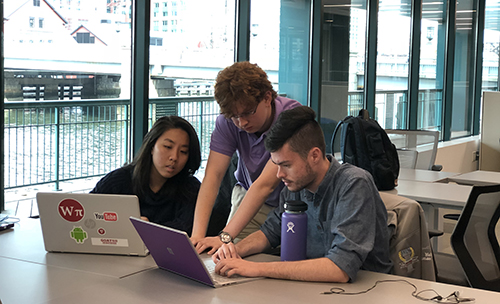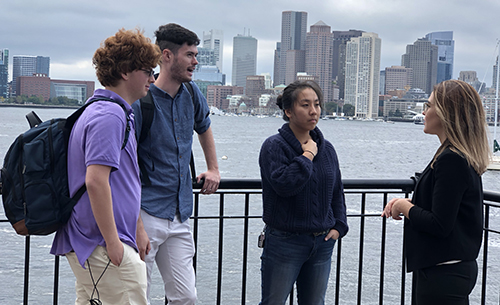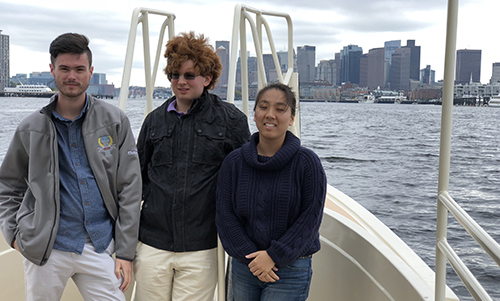Boston Waterfront Project

WPI Boston Project Center: Making the Most of Boston Harbor’s Mixed Use Waterfront Space
Student Project Explores Possibilities for Business, Government, and Community Uses
As a waterfront community with mixed uses, Boston Harbor presents challenges for future development. With industrial, maritime, commercial, recreational, and residential areas side-by-side, understanding a holistic picture of Boston’s waterfront is essential to the success of growth and expansion.

The student team working at the Boston Project Center
At WPI’s Boston Project Center, a team of students worked in collaboration with project sponsor Boston Harbor Now to study opportunities to promote multiple uses for future growth and function. The student team included computer science major Ching Wing Cheng, electrical and computer engineering major Tyler Morris, and computer science major Thomas White. As part of their Interactive Qualifying Project (IQP)—a project that requires teams to delve into problems that matter to real people—the students investigated, identified, and suggested mixed uses in Boston’s waterfront.
Jill Valdes Horwood, director of policy for Boston Harbor Now, says the organization was seeking ideas for mixed uses on an operating waterfront. Proposed ideas needed to be exciting but within the real boundaries of what might be possible, allowed, and useful within an industrial waterfront.
“Boston Harbor Now is focused on improving the working port and really creating a 21st century waterfront,” she says. “The students are helping us put together mixed uses that are compatible with existing working waterfront industrial businesses.”
- Jill Valdes Horwood, Project Sponsor
Team members considered the project impact on the surrounding residential communities and designated port areas (areas with geographic or physical attributes making the area conducive to industrial maritime uses). The team worked with Boston Harbor Now to propose recommendations that reflect community wishes, are helpful to public and state agencies currently working on these issues, and that do not interfere with the port uses.

The student team on a Boston water taxi tour during project field work
With a vibrant residential community and an essential active port, incorporating the different uses when possible and keeping them separate when necessary became an overarching goal. “With our project, we're looking to impact the community, the city, and, the state,” says team member White. “The state is who oversees designated port areas. The city tries to plan what happens in those areas. And, the community is really the people who will supply the ideas and benefit the most from it.”
- Thomas White, Junior

A team meeting with sponsor Jill Valdes Horwood during project field work
Boston Harbor Now asked the students to deliver a few case studies of ways the area could employ mixed use that would be agreeable to residents and business leaders alike. Working in the Boston Project Center space in the Seaport district, in the offices of Boston Harbor Now, and in the field impressed upon the students the project’s many layers.
According to White, the team’s preliminary research included evaluating waterfront areas around the world that have mixed uses and are facing similar challenges like potential flooding. “Our project is currently preliminary research, and we're trying to suggest things that have been done in other areas around the world to see if they would fit in the context of Boston and the climate changes we are facing,” he says.
Horwood, who has worked with WPI teams previously, says open communication with the students and their ability to manage so many facets of the project was invaluable. “I think the engagement with them is really critical—not only for periodic check-ins, but it gives us the opportunity to talk through some ideas and get to know each other and really push each other to that next level,” she says. “I welcome their process-oriented and meticulous kind of thinking. It really adds a lot to my work in a way that would not be there if I didn't have these really wonderful minds contributing to that thought process.”

Exploring the Boston Harbor waterfront from a water taxi
Using research from the office and the field, students proposed several possibilities. A climate-resilient park incorporated cutting-edge technology and products such as using a water-absorbent concrete in the space that would help store excess water in times of severe weather or high tides while providing open public space during calmer times.
Another proposal included making East Boston’s “Golden Stairs” a more visible tourist attraction. These stairs were generally an immigrant’s entrance to Boston after disembarking at Boston Harbor’s immigration station. The team also proposed an urban beach, similar to Sugar Beach in Toronto, where supplied sand covers an industrial lot and makes an area that’s attractive, useful, and also moveable. Horwood even appreciated the ideas that were more “outside the box” (Ferris wheel, anyone?), but had success in other parts of the world.
Proposing another use that blends residential and industrial use, the team recommended developing a community center that is 100 percent focused on the maritime industry, says Horwood. “It could be educational, a community space, a community meeting place,” she says. “It offers an opportunity to visit the industrial waterfront without having to be in it.” Visitors would be able to appreciate the industry activities in an immersive way—watching the movement of cranes and barges, for instance.
Teamwork proved essential. The students collaborated while also respecting each other’s work style. “We allow each person to work on their own,” says Cheng. “But then at the end of each day we come together and basically review our work together as a team to make it flow more as one project instead of three separate sections of one project.”

Conducting field work and gathering data in the Boston waterfront area
Boston Harbor Now’s team will use the results of the IQP to bring before state, local, and community groups to serve as discussion points for the potential within Boston Harbor communities.
Eventually, says Horwood, the designs could become a reality.
“I truly believe the recommendations they are formulating are going to be incorporated into a larger two-year project,” she says. “They are going to be physical items that we can visit and see and enjoy as a result of the students’ work, and are going to be part of that Boston Harbor culture.”
- Jill Valdes Horwood, Project Sponsor